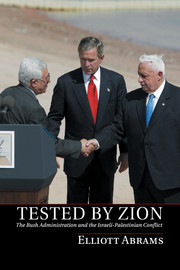Book contents
- Frontmatter
- Contents
- Acknowledgments
- Introduction
- 1 Early Days
- 2 9/11 and the Search for a Policy
- 3 Roadmap to Disengagement
- 4 “New Realities on the Ground”
- 5 Arafat, Disengagement, Sharon
- 6 Olmert – Peace or War?
- 7 War in Lebanon – and Condi
- 8 From Mecca to Annapolis
- 9 The “Meeting” at Annapolis
- 10 Two Trips to Jerusalem
- 11 Final Days in Gaza and Turtle Bay
- 12 Lessons Learned
- 13 Conclusion
- Index
- References
3 - Roadmap to Disengagement
Published online by Cambridge University Press: 05 January 2013
- Frontmatter
- Contents
- Acknowledgments
- Introduction
- 1 Early Days
- 2 9/11 and the Search for a Policy
- 3 Roadmap to Disengagement
- 4 “New Realities on the Ground”
- 5 Arafat, Disengagement, Sharon
- 6 Olmert – Peace or War?
- 7 War in Lebanon – and Condi
- 8 From Mecca to Annapolis
- 9 The “Meeting” at Annapolis
- 10 Two Trips to Jerusalem
- 11 Final Days in Gaza and Turtle Bay
- 12 Lessons Learned
- 13 Conclusion
- Index
- References
Summary
The Bush speech was a clear statement of policy: When there was an end to terror and corruption, and the reform of Palestinian institutions was creating a democracy, the United States would lead the Palestinians to statehood. But how was all this to happen? How would the Palestinian reform, which required the marginalization of Arafat, be foisted on Arafat and his cronies in Fatah and the PLO? How would the reduction in terrorism, which Bush had made a prerequisite for progress, come to pass? And what roles would other states, Arab and European, play? For that matter, what role would the State Department play, after the arresting cameo on June 24 – not just Powell but also Rice and Rumsfeld appearing with the president as he spoke? The evolution of Bush's thinking had threatened not only Arafat and his coterie but also Powell and his, because Bush had rejected the traditional State Department approach. The “peace process,” involving endless negotiating sessions with Arafat, had been declared bankrupt. Was it now to be U.S. policy to cheer for Palestinian reforms – or to impose them? The administration had no answers on June 24.
Yet one motivation for involvement in Israeli-Palestinian issues had been the coming confrontation with Iraq – by the time of the June speech, only nine months away. It was easy to argue, then, that silence and inactivity could not be the follow-on to the June speech, and it was not hard to persuade the president that some tactic or program was needed. For whatever other actors had in mind, the president was sincere: He believed he had found a formula, indeed the only workable formula, for achieving Middle East peace. If there were good ideas about how to make this experiment work, he was fully open to them. The potential vacuum was soon filled by several parties, beginning with Quartet activity at the United Nations, then involving more nations and international institutions like the World Bank, and finally coalescing around the production of a “Roadmap” toward Palestinian statehood.
- Type
- Chapter
- Information
- Tested by ZionThe Bush Administration and the Israeli-Palestinian Conflict, pp. 48 - 97Publisher: Cambridge University PressPrint publication year: 2013



